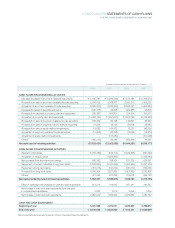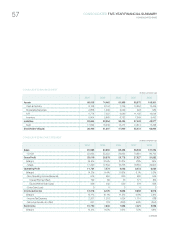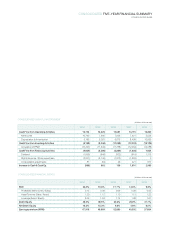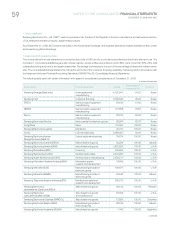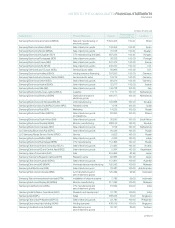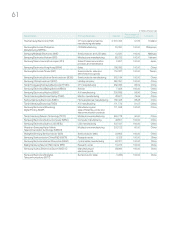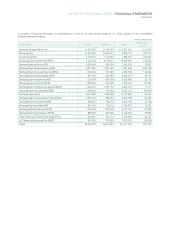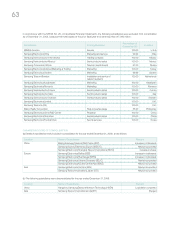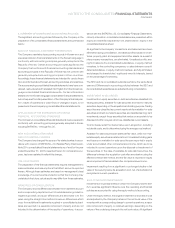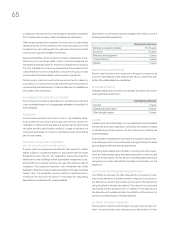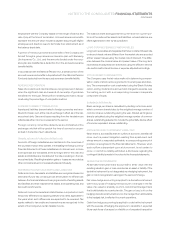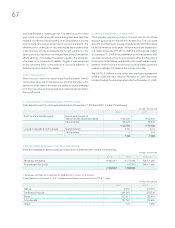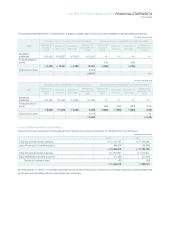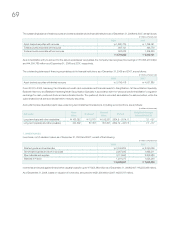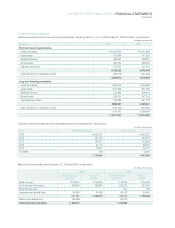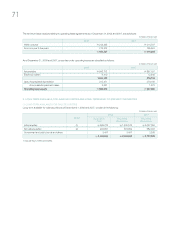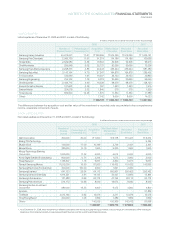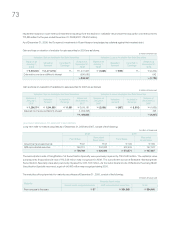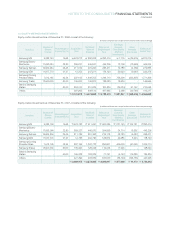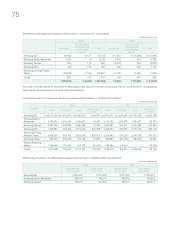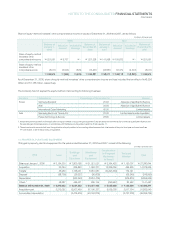Samsung 2008 Annual Report Download - page 68
Download and view the complete annual report
Please find page 68 of the 2008 Samsung annual report below. You can navigate through the pages in the report by either clicking on the pages listed below, or by using the keyword search tool below to find specific information within the annual report.
employment with the Company based on their length of service and
rate of pay at the time of termination. Accrued severance benefits
represent the amount which would be payable assuming all eligible
employees and directors were to terminate their employment as of
the balance sheet date.
A portion of the accrued severance benefits of the Company are
funded through a group severance insurance plan with Samsung
Life Insurance Co., Ltd., and the amounts funded under this insur-
ance plan are classified as a deduction from the accrued severance
benefits liability.
In accordance with the National Pension Act, a certain portion of the
accrued severance benefits is deposited with the National Pension
Fund and deducted from the accrued severance benefits liability.
REVENUE RECOGNITION
Sales of products and merchandise are recognized upon delivery
when the significant risks and rewards of ownership of goods are
transferred to the buyer. Revenue from rendering services is recog-
nized using the percentage-of-completion method.
FOREIGN CURRENCY TRANSLATION
Assets and liabilities denominated in foreign currencies are trans-
lated into Korean won at the rate of exchange in effect as of the bal-
ance sheet date. Gains and losses resulting from the translation are
reflected as either income or expense for the period.
Foreign currency convertible debentures are translated at the
exchange rate that will be used at the time of conversion as pre-
scribed in the terms of such debentures.
TRANSLATION OF FOREIGN OPERATIONS
Accounts of foreign subsidiaries are maintained in the currencies of
the countries in which they operate. In translating the foreign currency
financial statements of these subsidiaries into Korean won, income
and expenses are translated at the average rate for the year and
assets and liabilities are translated at the rate prevailing on the bal-
ance sheet date. Resulting translation gains or losses are recorded as
other comprehensive income presented as part of equity.
DEFERRED INCOME TAX ASSETS AND LIABILITIES
Deferred income tax assets and liabilities are recognized based on
estimated future tax consequences attributable to differences
between the financial statement carrying amounts of existing assets
and liabilities and their respective tax bases, and operating loss and
tax credit carryforwards.
Deferred income tax assets and liabilities are computed on such
temporary differences by applying statutory tax rates applicable to
the years when such differences are expected to be reversed. Tax
assets related to tax credits and exemptions are recognized to the
extent of the Company’s certain taxable income.
The balance sheet distinguishes the current and non-current por-
tions of the deferred tax assets and liabilities, whose balances are
offset against each other by tax jurisdiction.
LONG-TERM RECEIVABLES AND PAYABLES
Long-term receivables and payables that have no stated interest rate
or whose interest rate are different from the market rate are recorded
at their present values using the market rate of discount. The differ-
ence between the nominal value and present value of the long-term
receivables and payables are amortized using the effective interest
rate method with interest income or expense adjusted accordingly.
STOCK-BASED COMPENSATION
The Company uses the fair-value method in determining compen-
sation costs of stock options granted to its employees and direc-
tors. The compensation cost is estimated using the Black-Scholes
option-pricing model and is accrued and charged to expense over
the vesting period, with a corresponding increase in a separate
component of equity.
EARNINGS PER SHARE
Basic earnings per share is calculated by dividing net income avail-
able to common shareholders by the weighted-average number of
common shares outstanding during the year. Diluted earnings per
share is calculated using the weighted-average number of common
shares outstanding adjusted to include the potentially dilutive effect
of common equivalent shares outstanding.
PROVISIONS AND CONTINGENT LIABILITIES
When there is a probability that an outflow of economic benefits will
occur due to a present obligation resulting from a past event, and
whose amount is reasonably estimable, a corresponding amount of
provision is recognized in the financial statements. However, when
such outflow is dependent upon a future event, is not certain to
occur, or cannot be reliably estimated, a disclosure regarding the
contingent liability is made in the notes to the financial statements.
DERIVATIVE INSTRUMENTS
All derivative instruments are accounted for at fair value with the
resulting valuation gain or loss recorded as an asset or liability. If the
derivative instrument is not designated as a hedging instrument, the
gain or loss is recognized in earnings in the period of change.
Fair value hedge accounting is applied to a derivative instrument
with the purpose of hedging the exposure to changes in the fair
value of an asset or a liability or a firm commitment (hedged item)
that is attributable to a particular risk. The gain or loss, both on the
hedging derivative instrument and on the hedged item attributable
to the hedged risk, is reflected in current operations.
Cash flow hedge accounting is applied to a derivative instrument
with the purpose of hedging the exposure to variability in expected
future cash flows of an asset or a liability or a forecasted transaction
NOTES TO THE CONSOLIDATED FINANCIAL STATEMENTS
CONTINUED


